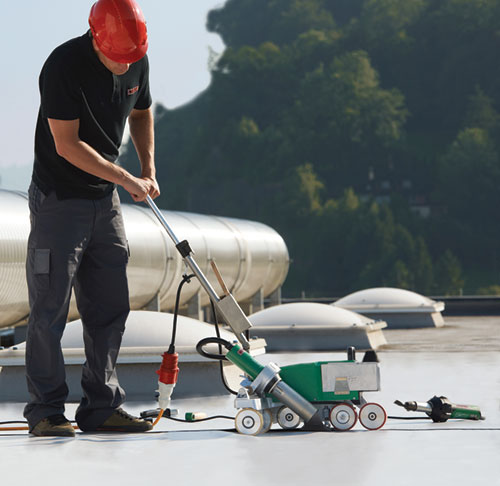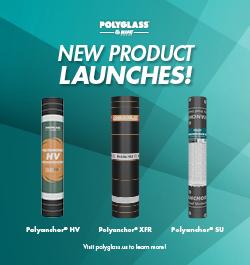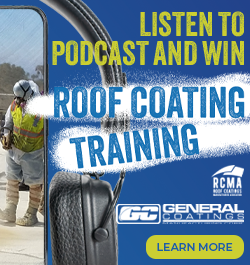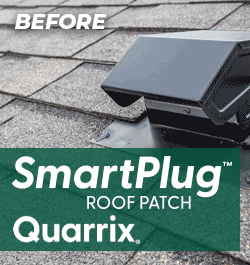Hot Air Welding Done Right

Hot air welding thermoplastic seams under changing environmental conditions.
By Mike Russo.
Today’s most powerful hot-air welders for overlap welding of thermoplastic membranes are advertised to achieve speeds of up to 18 meters (59 feet) per minute. That’s fast enough to quickly ruin a roofing contractor’s day.
These robotic welders are digitally monitored to achieve consistent overlap welding performance, but they cannot adapt to changing environmental conditions automatically. It’s the contractor’s job to monitor and assess seam quality before the base seam is welded and when ambient temperatures or other factors potentially influence welding performance.
Successful hot-air welding requires the use of specialized, properly maintained and adjusted equipment operated by experienced personnel familiar with hot-air welding techniques. Achieving consistent welds is a function of ensuring that the roofing membrane surface is clean and prepared for heat welding, conducting test welds to determine proper equipment settings, and evaluating weld quality after welding has been completed.
Setting up hot-air robotic welders properly is the key to having a properly installed thermoplastic roof, and performing test welds is one of the most important steps. Making appropriate adjustments before the welding process begins ensures that the correct combination of welder speed, heat output and pressure is programmed into the robotic welder.
For most roofing professionals, these procedures have been firmly established in the minds of their crews and equipment operators through education and field training. But let’s not forget that Murphy’s Law often rules on both large and small low-slope roofing projects.
The frightening reality about using robotic welders is if they are set-up incorrectly or environmental conditions change, the applicator may weld thousands of feet of non-spec seam before anyone even bothers to check. If you probe for voids at the end of the day, it is probably too late.
If serious problems are discovered, the applicator must strip in a new weld via adhesive, cover tape, or heat welding, depending on what the membrane manufacturer will allow. If seams must be re-welded, the operator has to create not one, but two robotic welds on each side of the cover strip. The sheet will also need to be cleaned and re-conditioned no matter what method is used.
Can these errors be corrected? Absolutely. Except now the crew is in a real hurry because the roofer is working on his own time, and application errors tend to snowball under these conditions.
Reality Check
What goes on in the field is sometimes quite different than what one sees when hot-air welding thermoplastics under an expert’s supervision. To support this view, we asked four field service reps, each with a minimum of 35 years of roofing experience, to comment. The most senior “tech” has worked for six different thermoplastic membrane manufacturers in his career.
Their names shall remain anonymous, but this writer will be happy to put readers in touch with them upon request. So, let’s welcome Christian, Dave, Mark and Walter, and get straight to the point: Is the average roofing crew diligent enough when it comes to properly testing welds using industry best practices?
“I would say ‘probably not,” exclaims Walter. Dave just shakes his head as his colleague Mark adds, “I would have to say ‘no’.”
Considering the generally laudable performance of thermoplastic membranes over the last decade or so, we must interpret our experts’ opinions as suggesting the need for further improvement in hot-air welding techniques.
Hence, the purpose of this article.
“There are a few outstanding issues causing bad welds,” says Walter. “These include welding over dirty or contaminated membranes; improper equipment setup; using crews with inadequate training; and knowing the difference between the weldability of various manufacturers’ membranes.”
Welding equipment consists of three main components: the power supply, the hot air welder (either automatic or hand-held), and the extension cord. A stable power supply of adequate wattage and consistent voltage is critical to obtaining consistent hot air welds and to prevent damage to the welder.
The use of a contractor-supplied portable generator is recommended, although house-supplied power may be acceptable. Relying on power sources that are used for other equipment that cycle on and off is not recommended. Power surges and/or disruptions and insufficient power may also impact welding quality. Proper maintenance of welding equipment is also of obvious importance.
“Contractors seem to never have enough power on the roof,” observes Mark. “The more consistent your power is, the more consistent your welds will be. Too many times, I’ve seen too many tools (hand guns, auto welder, screw guns and a RhinoBond machine) plugged into one generator.” Generator-induced challenges on the jobsite are going to arise, agrees Christian. “But at least today there is more experience in understanding, dealing with, and ultimately preventing these issues,” he says.
Most TPO and PVC membrane suppliers also recommend using the latest automatic welding equipment, which provides improved control of speed, temperature and pressure. Our four experts generally agree that field welding performance has improved over the years and programmable robotic welders have helped. They also point to proper training and experience as crucial factors.
For Mark, it’s all about the applicator being familiar with his or her equipment. “The fan motors on some of the newer welders are larger, which means your gun is hotter,” he says. “Other hand-held welders don’t blow as much air. This means if an applicator picks up a new hand gun, there will be a learning curve to deal with. Ideally, this is addressed before the real welding begins.”
Education should always include safety training, notes Dave. “I feel that safety is job one and like the fact that there is a welder available that keeps you from having to walk backward and possibly off the roof,” he says.
What’s more, successful hand welding is a skill that involves individual technique, normally developed and refined over time. This means that operators should be proficient in different nozzle configurations, because the correct selection of welder temperature and nozzle width can have a significant effect on the quality of the hand weld.
“Not all guns run at the same temperature at the same heat setting, so I tell contractors to number their guns,” adds Mark. Christian agrees that education and communication between supervisors and crews can be vital because robotic welder performance varies by model and environmental conditions.
When welding in cold weather, the thermoplastic membrane needs to be “pre-heated” before the weld is compressed. While an automatic welder has holes in the nozzle that pre-heat the membrane, hand guns do not. “When I watch most installers weld, they hold the roller too close to the nozzle, which does not allow the membrane to pre-heat,” says Mark. “I suggest they keep the roller at least 1 or 2 inches away from the tip.”
The ability to achieve satisfactory welds with the hot-air welder being held in either hand facilitates welding at various angles and in tight spots. Because few installers are ambidextrous by nature, it’s mostly experience with these types of details that counts. And therein lays a major problem for roofing contractors in general—finding and keeping qualified labor.
“Just putting a probe to a seam will not ensure against leaks, especially in colder weather where roofs do not ‘probe out’ as well,” says Mark. “It’s the training of installers that is most critical to the water tightness of the roofing system.”
When hand-welding with a roller, finger pressure is often used to place and “tack” the upper piece of membrane into position. However, a hard silicone roller must always be used for final welding. Tack-welded field seams will not pass inspection.
The membrane is typically heat-welded together using the “two-pass” method. The installer welds from the interior of the seam on the first pass and finishes the weld with the second pass. The nozzle is placed between the two layers of membrane, and the roller is used to compress the membrane and create the bond. Ideally, welds should be continuous, without voids or partial welds.
Sounds simple, doesn’t it? It can be, unless your body is contorted around a raised pipeline, it’s 100 degrees Fahrenheit in the shade, and a hot wind is picking up all kinds of potential seam contaminants and blowing them in your direction. Defects are usually corrected by heat welding another layer of reinforced membrane over the deficient weld area the same day, assuming the interior of the seam has not been contaminated.
Equipment Setup and Test Welding
Roofing professionals know all about the importance of setting up robotic welders and performing test welds before going into action in the morning. However, membrane manufacturers would like to see crews test weld at the beginning of every work period, including when returning from lunch in the afternoon. They also recommend testing when there’s a significant change in the weather, including changes in air temperature, wind speed, cloud cover, etc.
Lower air temperatures and overcast skies will generally require a slower speed than would be required with higher temperatures and sunny skies. For initial automatic hot-air welder settings, one expert recommends the formula below. It is not foolproof, but is a good starting point under average weather conditions:
Speed Formula = ambient temp/10 + 2=FPM (feet per minute). For example: 80/10 + 2=10 FPM.
“If an applicator anticipates a large swing in ambient temperature from hot to cold—think Chicago in fall—he can set the welder closer to the 1.5-inch weld setting,” says Dave. “This way, as the temperature drops the weld will stay within the manufacturer’s required seam width parameters.” Typically, membrane manufacturers want to see delamination of a test seam of a least 1 inch but not more than 1.5 inches. Dave estimates that a conscientious contractor will perform at least two test welds per day. “In a worst-case scenario, they realize that what worked yesterday might not work today,” he says.
Many factors will affect welder settings, including membrane type (TPO, PVC) and thickness. “TPO and PVC weld differently,” says Dave. “You want to be running the welder hotter with PVC and see smoke and bleed-out at the edge of the seam. If you smoke or bleed-out TPO, you’ve overheated the sheet and pretty much compromised the weld.”
To avoid that situation, test welding is required using “bag fresh” membrane approximately 18 inches long. For full size automatic welders, one membrane manufacturer suggests using the scenario below, keeping in mind Mark’s comment that new equipment may run faster or hotter than anticipated.
Finally, weld the two 18-inch pieces of membrane together at the agreed-up setting and allow the membrane to cool for at least 10 minutes. Cut 1-inch-wide strips across the 18-inch welded membrane and test each weld by applying enough pressure to cause the seam to peel apart.
An acceptable weld will fail by exposing the scrim reinforcement, otherwise called a “film tearing bond.” A partial weld will fail in a peel test by a partial separation between the two layers of the membrane. Finally, a “cold” or “false” weld will fail by a full separation between the two layers of membrane.
“You can put the sample on an Instron machine (in a test facility) for greater precision,” says Dave, “but a properly-performed peel test conducted on the roof is usually satisfactory. In addition, a visual inspection can determine adequacy of weld width; presence of fasteners and plates within the weld area; overheating or tearing within the weld area; indications of special sealing at T-joints; and, serious under-heating or skipping of seam areas.
Physical probing involves the use of a blunt pointed seam probe such as a dulled cotter pin puller. The weld must be allowed to cool before being probed. The probe tool is pressed with some force against the weld edge and drawn along the seam. The probe tool will enter into the heat weld area between the two layers of membrane at locations where the seams are partially welded and a “void” is found. The probe tool can then be used to follow the problematic seam area until a solid (spec) weld is encountered.
The roof inspector may also ask to see test welds and conduct probes and visual observation, but most manufacturers avoid destructive testing when monitoring seam strength on a roof install. “Welding performance over the years has improved as a result of active communication and training,” concludes Christian. “In particular, training on the welding window and machine set up have been the drivers of improved welding performance.”
Contractors can learn more about Leister welding equipment online at www.leister.com.
Editor’s note: This article was first published in Roofing Magazine and can be viewed here.








-2.png)









Comments
Leave a Reply
Have an account? Login to leave a comment!
Sign In